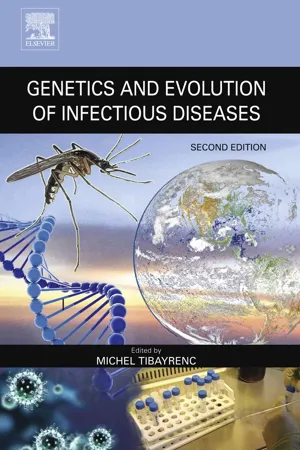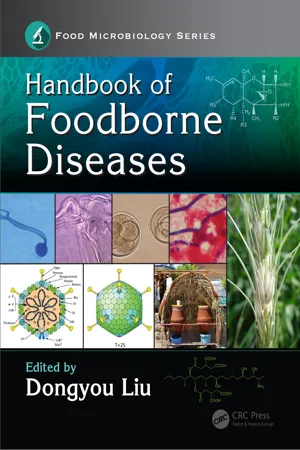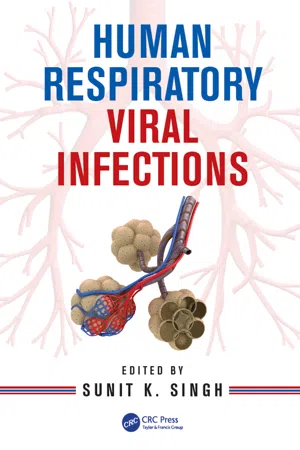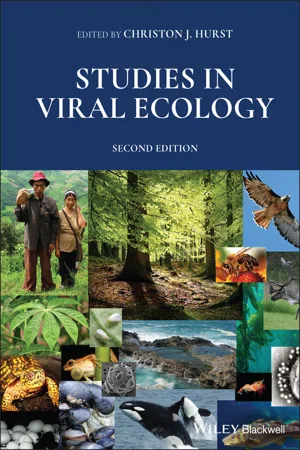Avian Flu
Avian flu, also known as avian influenza, is a highly contagious viral infection that primarily affects birds. It can also spread to humans and other animals, posing a significant public health concern. The virus can cause severe illness and has the potential to lead to outbreaks with serious implications for both animal and human populations.
5 Key excerpts on "Avian Flu"
- eBook - ePub
- Michel Tibayrenc(Author)
- 2017(Publication Date)
- Elsevier(Publisher)
...27 Ecology and Evolution of Avian Influenza Viruses A.C. Hurt 1, 2, R.A.M. Fouchier 3, and D. Vijaykrishna 4 1 WHO Collaborating Centre for Reference and Research on Influenza, VIDRL, at the Peter Doherty Institute for Infection and Immunity, Melbourne, VIC, Australia 2 University of Melbourne, Parkville, VIC, Australia 3 Erasmus Medical Center, Rotterdam, the Netherlands 4 Duke-NUS Graduate Medical School, Singapore, Singapore Abstract Influenza A viruses have been isolated from many animal species, but wild waterfowl and shorebirds are recognized as their natural reservoirs due to the prevalence of the highest diversity of influenza A virus among these hosts. Influenza A viruses detected over the past century in the majority of mammalian hosts can be phylogenetically traced back to their ancestors in waterfowl or shorebirds. Although many wild bird species may harbor avian influenza viruses, birds belonging to the Anseriformes (ducks, geese, and swans) and Charadriiformes (gulls, terns, and waders) constitute the primary natural virus reservoir. Avian influenza viruses are primarily transmitted via the fecal–oral route, which allows the effective transmission of influenza A viruses between susceptible birds and potentially allows temporal and spatial connectivity of virus populations in different host (sub)populations. Avian influenza viruses are normally asymptomatic in wild birds, or cause mild disease in poultry, and therefore are termed low pathogenic avian influenza (LPAI) viruses. However, the acquisition of a multibasic cleavage site in the hemagglutinin protein genes of H5 and H7 subtype influenza A viruses can cause a highly pathogenic avian influenza (HPAI) virus resulting in severe disease in poultry and wild birds. In this chapter, we review the avian influenza virus literature to discuss the ecology and evolution of LPAI and HPAI viruses in birds. Keywords Avian; Ecology; Evolution; Genetics; Influenza; Migration 1...
- eBook - ePub
- Dongyou Liu, Dongyou Liu(Authors)
- 2018(Publication Date)
- CRC Press(Publisher)
...4 Avian Influenza Virus E. Spackman Contents 4.1 Introduction 4.2 Classification, Morphology, and Structure 4.3 Biology 4.4 Epidemiology 4.5 Clinical Features 4.6 Pathogenesis 4.7 Diagnosis 4.8 Treatment 4.9 Prevention 4.10 Conclusions and Future Perspectives References 4.1 Introduction Avian influenza virus (AIV) is type A influenza that is adapted to avian hosts. Although the virus can be isolated from numerous avian species, the natural reservoir species are dabbling ducks, shorebirds, and gulls. Domestic poultry species (poultry being defined as birds, their eggs, or progeny that are raised for consumption) are generally not natural hosts. Some species of domestic ducks are a special case because they are closely enough related to dabbling ducks that they are easily infected with AIV and can carry the virus asymptomatically. Despite their close relationship (and very likely sharing a common ancestor within the past few centuries 1), AIV differs in biology and epidemiology from human influenza (seasonal flu), which infects thousands of people yearly. In general, human infections with AIV are relatively rare, as of March 2017 about 2300 cases have been confirmed since the 1970s (Table 4.1). 2 – 6 As a foodborne illness, human infection and disease caused by AIV are not typical because ingestion of food is not the usual route of exposure. Human exposure to the AIV is associated almost exclusively with slaughter, food preparation, and handling of uncooked poultry products. Table 4.1 Confirmed Cases of Avian Influenza Virus Infections in Humans as of March 21, 2017 4.2 Classification, Morphology, and Structure Avian influenza virus is type A influenza, a member of the Orthomyxoviridae family. It is a single-stranded RNA virus with a segmented genome that facilitates rapid mutation. It is also an enveloped virus, and therefore has limited environmental stability...
- eBook - ePub
- Sunit K. Singh, Sunit K. Singh(Authors)
- 2014(Publication Date)
- CRC Press(Publisher)
...24 Emergence and Pathogenesis of Avian Influenza in Humans Jennifer R. Plourde and Kevin S. Harrod CONTENTS 24.1 Introduction 24.2 Pathogen 24.3 H5N1 Virus Replication 24.4 Epidemiology 24.5 Human Infection with Avian Subtypes H7N7, H7N3, and H9N2 24.6 Clinical Features in Humans 24.7 Pathogenesis 24.8 Neurological Manifestations of H5N1 Infection in Humans 24.9 Immunity 24.9.1 Innate Immunity 24.9.2 Cellular Immunity 24.10 Diagnosis and Treatment 24.11 Prevention and Control 24.11.1 Vaccination in Poultry 24.11.2 Human Vaccines References 24.1 INTRODUCTION Influenza viruses cause global epidemics annually and occasional pandemics, such as the 1918 “Spanish influenza” and the more recent 2009 H1N1 “Swine flu” pandemic. 1 Three to five million humans are infected with influenza viruses worldwide each year, with an estimated 250,000–500,000 deaths. 2 The virus typically causes a mild or severe respiratory illness that commonly presents as a sudden onset of fever, myalgia, dry cough, headache, sore throat, runny nose, anorexia, and generally feeling unwell. 2, 3 This highly contagious virus is easily transmissible among humans, and an incubation time of approximately 1–5 days assists in the widespread transmission of the disease. 2, 3 Vaccines are available for the expected. circulating strains of seasonal influenza at the beginning of the influenza season each year, and vaccination has been estimated to prevent approximately 60% of influenza infections but varies each season. 4 Despite a global immunization effort, influenza epidemics continue with new strains arising with resistance to immunization...
- eBook - ePub
- Christon J. Hurst, Christon J. Hurst(Authors)
- 2021(Publication Date)
- Wiley-Blackwell(Publisher)
...Virus (WNV) Numerous Africa, Europe, Asia, Americas WNV encephalitis Usutu virus Orthomyxoviridae Influenza A virus Avian influenza virus Waterfowl (Anatidae), shorebirds (Charadriiformes) Worldwide Avian influenza Paramyxoviridae Paramyxovirus Newcastle Disease Virus (APMV‐1) Numerous Worldwide Newcastle disease Metapneumovirus Avian pneumovirus Turkey (Phasianidae) Americas, Asia, Europe, Africa Turkey rhinotracheitis Picornaviridae Hepatovirus Avian encephalomyelitis virus Chicken, turkey (Phasianidae) USA encephalitis Duck hepatitis virus (DHV) type 1 and 3 Domestic duck (Anatidae) Americas, Asia Hepatitis Retroviridae Alpharetrovirus Avian leukosis sarcoma. virus (ALSV) Europe Leukotic disease Togaviridae Eastern equine encephalitis (EEE) Songbirds (Passeriformes) Americas EEE Alphavirus Buggy creek virus House sparrow (Passer domesticus), cliff swallow (Petrochelidon pyrrhonota) Americas The classification of the avian viruses in this table is based on genome type. This table represents the currently best‐studied avian viruses and does not present a complete overview of all avian viruses currently known. 14.2 AN EXAMPLE: INFLUENZA A VIRUSES Influenza A viruses are probably best known for their ability to cause pandemics and subsequent annual epidemics in humans, with the 1918 H1N1 Spanish influenza and the 2009 H1N1 Swine origin pandemics as prime examples. In addition, during the past two decades outbreaks of HPAI virus, such as the HPAI H5 outbreaks, gained a high profile in both the scientific community and the general public. Less well known is the fact that influenza A viruses naturally circulating in wild birds are the progenitors, either directly or indirectly, of all pandemic and HPAI viruses (Webster et al. 1992). Besides being prevalent in humans, influenza A viruses have been isolated from many other species including pigs, horses, mink, dogs, cats, marine mammals, and a wide range of domestic birds...
- eBook - ePub
- Irina Kiseleva, Natalie Larionova(Authors)
- 2021(Publication Date)
- Bentham Science Publishers(Publisher)
...The genetic relationship between human and swine influenza viruses also indicates their evolution from a common avian predecessor [ 35, 36 ]. Transmissibility of viruses from migratory waterfowl to other species is usually a consequence of mutations and reassortments [ 36, 37 ]. In exceptional cases, viruses of low virulence for wild birds, with new mutations can acquire high virulence (HPAI, highly pathogenic avian influenza) for other species of wild and domestic birds and mammals. Outbreaks of HPAI virus disease result in massive deaths in chickens and huge losses in the poultry industry [ 38 ]. HPAI H5N1 viruses first declared themselves in 1997 with the mass death of wild and domestic birds [ 15 ]. Now, they become a source of epizootics in 77 countries of three continents [ 17, 38, 39 ]. This has resulted in tens of millions of avian deaths, infections, and mortality in several mammalian species, including humans [ 40 ]. From the vast gene pool of avian influenza viruses, strains stably adapted to mammals have so far formed only four serotypes: H1, H2, and H3 for humans and pigs, H7 and H3 for horses, H3 for dogs [ 22, 23 ]. Recent data indicate that the list of animals susceptible to influenza viruses is much wider, and the pathways of interspecies transmission are more complicated than previously thought. Nonhuman primates were found to be naturally infected with seasonal human influenza viruses [ 19 ]. Cases of infection of domestic cats, tigers, leopards with HPAI viruses H5N1 were detected [ 20, 21, 41, 42 ]. Precedents of infection of minks on farms with influenza viruses of birds, pigs, humans, and cases of interstitial pneumonia, provoked in them by the bird H10N4 virus, have been noted [ 26, 28 ]. Unique mutations in the hemagglutinin molecule led to the evolution of the equine H3N8 virus into the canine influenza virus, with the development of severe respiratory disease in the new host [ 25 ]...




